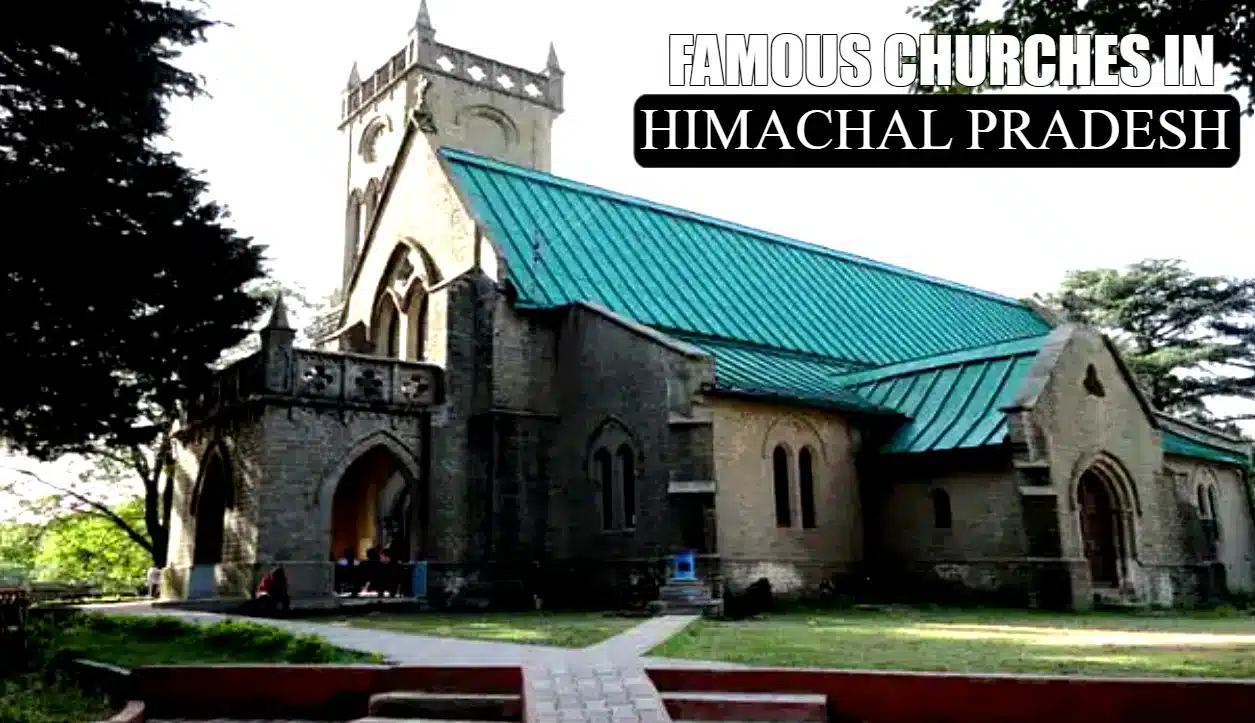The British Raj had a significant impact on the religious landscape of Himachal Pradesh, introducing Christianity to the region and constructing numerous churches that still stand today. These famous churches in Himachal Pradesh, often built in Gothic or Neo-Gothic styles, serve as enduring reminders of the colonial era and hold architectural, historical, and cultural significance.
The British presence in Himachal Pradesh dates back to the early 19th century when they established hill stations such as Shimla, Dalhousie, and Chail as summer retreats to escape the heat of the plains. These hill stations became popular among British officials, soldiers, and businessmen, and a significant British and European population gradually settled in the region. This growing Christian population required places of worship.
The construction of churches in Himachal Pradesh during the British era was primarily driven by the need to provide places of worship. The British government also played a role in promoting Christianity in the region, and many churches were built with financial assistance from the government.
Architecture and Design of the Churches in Himachal Pradesh
The churches in Himachal Pradesh built during the British era were often designed in European architectural styles, such as Gothic and Neo-Gothic. These churches continue to stand today as reminders of the British colonial era in Himachal Pradesh. The presence of a significant British and European population in Himachal Pradesh also had a significant impact on the region’s culture. For example, British influence is evident in the region’s cuisine, architecture, and education system. Overall, the British presence in Himachal Pradesh had a profound impact on the region’s history, culture, and landscape. The churches built during this time are a testament to this impact, and they continue to be important landmarks in the region today.
Christ Church, Shimla: A Majestic Witness to History
Located beneath the awe-inspiring Jakhoo hill on The Ridge, Christ Church stands as an iconic symbol of Shimla, commanding breathtaking views of the snow-capped Himalayan ranges. Since its establishment in 1857, this magnificent structure has remained the heart and soul of the town. Crafted from stone and brick using neo-Gothic elements, Colonel J.T. Boileau laid the cornerstone on 9 September 1844, with Bishop Wilson of Calcutta consecrating the church on 10 January 1857. The completion of the spire in 1860 marked the installation of exquisite stained glass windows and the striking clock on the façade. However, the passage of time and heavy snowfall in 1961 caused significant damage to the building. Despite undergoing renovations, the church has managed to preserve its essence, with a nave, chancel, tower, and a floor boasting a central aisle and two side aisles lined with pews.
Today, Christ Church proudly stands as a testament to Shimla’s rich history and the enduring legacy of the British Raj. It is one of the most beautiful churches in Himachal Pradesh and a major tourist attraction in Shimla. Its silhouette dominates the landscape, captivating visitors who eagerly capture its beauty through the lens of their cameras, forever etching their memories of Shimla.
St. Michael’s Cathedral, Shimla: A Touch of French-Gothic Splendor
Dating back to 1886, St. Michael’s Cathedral was built by the Catholic community of Shimla. Lord Ripon, the Viceroy at the time, personally selected the site just below the Deputy Commissioner’s office on Mall Road. The cathedral boasts a distinctive French-Gothic architectural style, with its exterior crafted from dressed grey stone. Inside, the floor plan follows a cruciform design, featuring a nave, two aisles, a vestry, a baptistery, and a confessional. An organ, considered one of North India’s finest, was installed in 1913. The cathedral’s interior also showcases a recently restored tapestry of glass depicting the crucifixion, along with a statue of Our Lady of Guadalupe, a gift from the people of Mexico.
St. Mary’s Church, Kotgarh: A Serene Gem in the Apple Country
Nestled in the heart of Himachal’s apple-growing region in Kotgarh, St. Mary’s Church exudes charm and tranquility. Established in 1872 by the Moravian missionaries and the Church Missionary Society, this small wooden church has become a captivating attraction in the countryside.
Read in more detail about St Mary’s Church Kotgarh
Baptist Church, Kasauli: A Tranquil Sanctuary in the Pine Forests
Located amidst the pine forests near the Post Office at the start of Sadar Bazaar, the Baptist Church of Kasauli welcomes visitors with its peaceful ambiance. This petite structure, constructed in the 1920s, now falls under the jurisdiction of the Church of North India. The church’s architecture boasts a cruciform floor plan, adorned with exquisite stained glass windows. Three pews separated by two aisles lead to the altar, where a captivating depiction of Christ comforted by Joseph and Mary can be admired. The church also features a spacious courtyard and a cemetery housing graves dating back almost 150 years.
Christ Church, Kasauli: Where Serenity Meets Architectural Grandeur
Nestled at the bustling crossroad of Kasauli, Christ Church stands tall, supported by stone revetments and enveloped by majestic cedars and horse-chestnut trees. Originally a church of the Anglican Communion, it now falls under the jurisdiction of the Church of North India. The cruciform floor plan encompasses stunning stained glass windows above the altar, showcasing the poignant scene of the Crucifixion, with Joseph and Mary flanking the image of Christ. On 24 July 1853, Chaplain Thomas John Edward Steel M.A. of St. John’s College, Cambridge, inaugurated the church during divine service. It was consecrated on 8 January 1857 under the authority of the Bishop of Calcutta.
Church of St. John in the Wilderness, Mcleodganj: A Testament to Resilience
Along the road from Forsyth Ganj to Mcleodganj, enveloped by a serene grove of towering cedars, stands the Church of St. John in the Wilderness. This magnificent church, built with dark-dressed stone, bears witness to its resilience, having withstood the devastating Kangra earthquake of 1905. The surviving edifice reflects its former grandeur, adorned with beautiful Belgian stained-glass windows. Within the church compound lies an ancient graveyard, where an obelisk erected in memory of Lord Elgin, the Viceroy from 1862 to 1863, stands as a testament to history.
Church of St. John in the Wilderness, Palampur: A Tranquil Oasis Amidst Nature’s Splendor
Nestled amidst picturesque tea gardens, the Church of St. John in the Wilderness in Palampur captures the imagination with its idyllic countryside setting. The church was rebuilt in the 1920s after succumbing to the earthquake of 1905. Surrounded by vibrant warm-weather poinsettias and shaded by towering Himalayan cedars, this small church stands as a testament to resilience. The Palampur cemetery forms an integral part of the churchyard, adding to the allure of this serene sanctuary.
St. Patrick’s Church, Dalhousie: Grandeur in the Lap of Nature
Located on Military Hospital Road, St. Patrick’s Church proudly stands as the largest among all the churches in Dalhousie. Erected in 1909, this dressed-stone building remains in excellent condition. Within walking distance from Gandhi Chowk, the church was designed to accommodate a congregation of up to 300 people. Today, the Catholic Diocese of Jalandhar manages and maintains this magnificent church, adding to its spiritual significance.
St. John’s Church, Dalhousie: A Testament to Enduring Faith
Dating back to 1863, St. John’s Church holds the distinction of being Dalhousie’s oldest church. As a Protestant church, it showcases a chapel adorned with exquisite paintings of St. Peter and St. John. Housing a library with an extensive collection of books about Dalhousie, this church stands as a proud symbol of the town’s colonial heritage. Inspired by Rev. John H. Pratt, the Christian community joined hands to construct a stone structure reminiscent of the Roman Catholic Church of England.
St. Francis Church, Dalhousie: A Place of Worship Crafted by the Community
The Catholic community, along with the army and civil officers, contributed to the construction of St. Francis Church in 1894. This Catholic Church boasts remarkable stonework, and its colorful Belgian glass façade exudes unmatched beauty. A short walk from Subhash Chowk, this church is now managed and maintained by the Catholic Diocese of Jalandhar.
St. Andrew’s Church, Dalhousie: A Testament to Unity
Known as the Church of Scotland, St. Andrew’s Church was built in 1903 by the Protestant Christians of Ballon. Situated approximately one and a half kilometers from Dalhousie’s bus stand, this brick structure stands protected within a boundary wall.
Roman Catholic Church, Subathu: A Glimpse into History
Subathu, a cantonment town in Solan district, holds a significant place in history. The Subathu Cathedral, over 140 years old, bears witness to the town’s rich heritage. Constructed with meticulous detail using carved stones, this church encapsulates centuries of British rule. Serving as a reminder of the town’s historical significance, the Roman Catholic Church still stands tall today.
Roman Catholic Church Dagshai
Located within sight of Kasauli, Dagshai was established in 1847 as a military station or cantonment. The region encompassed five small villages, including Dagshai itself. The name “Dagshai” is believed to have originated from the branding of prisoners with hot irons, symbolizing the mark of the ruler. Under British rule, Dagshai thrived as a prominent military center and housed a large prison. The Roman Catholic Church was erected soon after the cantonment’s establishment, while a school served as the initial Protestant Church.
St. Patrick’s R.C. Church, Dagshai: A Testament to Faith and Sacrifice
The St. Patrick’s R.C. Church in Dagshai, built in 1852 by Irish soldiers at a cost of Rs. 5030, stands as a testament to faith and sacrifice. The architectural marvel, featuring gothic design elements, showcases intricate details such as stone carvings, heavy slate roofing, a single-piece stone cross, and seasoned teak wooden windows, doors, and furniture. Within the church, you’ll find the exquisite Italian marble altar dedicated to Lt. Marry Rebeca, a stone baptismal pond, and a statue of Mother Mary with child Jesus. The church also pays tribute to the Irish freedom fighter James Daly, who was bid a final farewell in this sacred space on 2nd November 1920.
St. Andrew’s Church, Chamba: A Symbol of Harmony
Chamba’s church stands as a testament to India’s secular tradition, where the Hindu rulers funded its construction and gifted it to the Christian community. The church owes its existence to the efforts of Dr. John Hutchison, a respected medical doctor and co-author of the renowned work, “History of the Punjab Hill States.” Raja Sham Singh of Chamba laid the foundation stone on 17th February 1899 as a mark of appreciation for Dr. Hutchison’s contributions. Completed on 7th May 1905, the church was then presented to the people of Chamba by Raja Bhuri Singh, the successor to the throne. Crafted from quarried dressed stone, the church showcases lancet windows and embodies the simplicity typically associated with Scottish churches.
Cultural and Historical Significance of Churches in Himachal Pradesh
These remarkable churches in Himachal Pradesh paint a vivid picture of the region’s cultural and historical significance. Each structure stands as a testament to architectural brilliance, enduring faith, and the harmonious coexistence of diverse communities. Visiting these churches offers a glimpse into the rich tapestry of Himachal’s heritage, captivating visitors with their beauty and stirring tales of the past.












